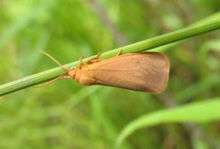Virbia aurantiaca
| Orange holomelina | |
|---|---|
 | |
 | |
| Scientific classification | |
| Kingdom: | Animalia |
| Phylum: | Arthropoda |
| Class: | Insecta |
| Order: | Lepidoptera |
| Superfamily: | Noctuoidea |
| Family: | Erebidae |
| Subtribe: | Arctiina |
| Genus: | Virbia |
| Species: | V. aurantiaca |
| Binomial name | |
| Virbia aurantiaca (Hübner, 1831)[1] | |
| Synonyms | |
Virbia aurantiaca, the orange holomelina, is a member of the family Erebidae found in North America.[4] In the east it has been recorded from Manitoba and Nova Scotia, south along the eastern seaboard to Cordoba in Mexico. It has also been recorded from Texas, Mississippi, Missouri, Tennessee, Louisiana, Oklahoma, Kansas, North Dakota and South Dakota.
The length of the forewings is about 10 mm for males and 9.7 mm for females. The male forewings range from clay to cinnamon. The hindwings are peach red with a raw umber subterminal band. The female forewings range from salmon to cinnamon with a faint olive brown discal spot. The hindwings are peach red with a brown discal spot and brown subterminal markings.
Larvae have been reared on dandelion and plantain species.[5]
References
- ↑ "Holomelina aurantiaca Hübner 1831 - EOL". Retrieved 2009-11-14.
- ↑ "Holomelina aurantiaca (Orange Holomelina Moth)". Retrieved 2009-11-14.
- ↑ "Species Detail BMONA". Retrieved 2009-11-14.
- ↑ "Species Holomelina aurantiaca - Orange Holomelina - Hodges#8121 -BugGuide". Retrieved 2009-11-14.
- ↑ Zaspel, J.M., Weller S.J. & Cardé, R.T., 2008: A faunal review of Virbia (formerly Holomelina) for North America North of Mexico (Arctiidae: Arctiinae: Arctiini). Bulletin of the Florida Museum of Natural History 48 (3): 59-118. Full article: .
| Wikimedia Commons has media related to Virbia aurantiaca. |
| Wikispecies has information related to: Virbia aurantiaca |